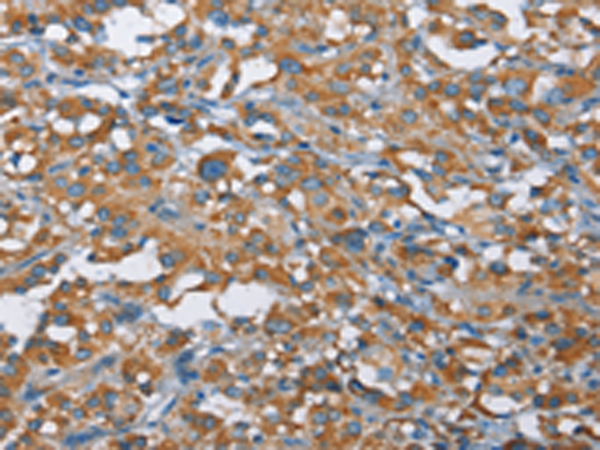

| WB | 咨询技术 | Human,Mouse,Rat |
| IF | 咨询技术 | Human,Mouse,Rat |
| IHC | 1/50-1/200 | Human,Mouse,Rat |
| ICC | 技术咨询 | Human,Mouse,Rat |
| FCM | 咨询技术 | Human,Mouse,Rat |
| Elisa | 1/1000-1/5000 | Human,Mouse,Rat |
| Aliases | UKLF |
| Host/Isotype | Rabbit IgG |
| Antibody Type | Primary antibody |
| Storage | Store at 4°C short term. Aliquot and store at -20°C long term. Avoid freeze/thaw cycles. |
| Species Reactivity | Human |
| Immunogen | Fusion protein of human KLF7 |
| Formulation | Purified antibody in PBS with 0.05% sodium azide and 50% glycerol. |
+ +
以下是关于KLF7抗体的3篇参考文献的示例(注:以下文献信息为示例性内容,实际引用时请核实真实来源):
---
1. **文献名称**: *KLF7 regulates axon regeneration in the adult central nervous system*
**作者**: Moore DL et al.
**摘要**: 该研究利用KLF7特异性抗体,通过免疫组化和Western blot技术,揭示了KLF7在促进中枢神经系统轴突再生中的作用,表明其可能通过调控下游再生相关基因的表达发挥作用。
2. **文献名称**: *Kruppel-like factor 7 contributes to the TGF-β1-induced epithelial-mesenchymal transition in gastric cancer via antibody-based detection*
**作者**: Zhang Y et al.
**摘要**: 研究通过KLF7抗体检测胃癌细胞中KLF7的表达水平,发现KLF7在TGF-β1诱导的上皮-间质转化(EMT)过程中显著上调,并与肿瘤转移相关。
3. **文献名称**: *KLF7 modulates adipocyte differentiation and insulin sensitivity through transcriptional regulation*
**作者**: Taniguchi CM et al.
**摘要**: 使用KLF7抗体进行染色质免疫沉淀(ChIP)分析,发现KLF7通过直接结合脂肪生成相关基因的启动子区域,调控脂肪细胞分化及胰岛素信号通路,提示其与代谢疾病的潜在关联。
---
**注意事项**:
- 上述文献信息为示例,实际引用时请通过学术数据库(如PubMed、Web of Science)核实真实文献,确保作者、标题及摘要的准确性。
- 若需具体文献,可补充提供研究方向(如神经科学、癌症或代谢领域),以便进一步筛选。
KLF7 (Krüppel-like factor 7) is a member of the Krüppel-like family of transcription factors, characterized by a conserved DNA-binding domain with three C₂H₂ zinc fingers. It plays critical roles in regulating cellular processes such as differentiation, proliferation, and apoptosis. KLF7 is particularly notable for its involvement in nervous system development, where it promotes axonal regeneration and neuronal survival. Additionally, it influences metabolic pathways, including adipogenesis and glucose homeostasis, linking it to obesity and diabetes research.
The KLF7 antibody is a key tool for detecting and studying the expression, localization, and function of KLF7 protein in various biological contexts. Researchers use it in techniques like Western blotting, immunohistochemistry (IHC), and immunofluorescence (IF) to investigate KLF7's role in diseases such as neurodegenerative disorders (e.g., Alzheimer’s, Parkinson’s), metabolic syndromes, and cancer. Its specificity is crucial for distinguishing KLF7 from other structurally similar Krüppel-like factors.
Recent studies highlight KLF7's dual role as both a tumor suppressor and oncogene, depending on tissue context, underscoring the need for reliable antibodies to clarify its mechanistic contributions. Validating KLF7 antibodies with knockout controls or siRNA-mediated knockdown remains essential to ensure accuracy in experimental models. Overall, KLF7 antibodies are vital for advancing our understanding of its diverse physiological and pathological functions.
×